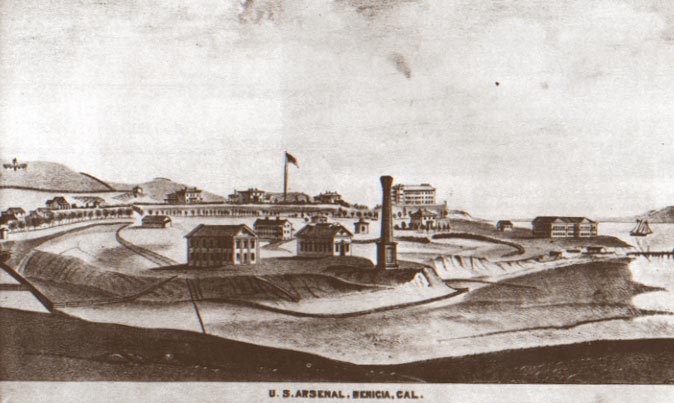- Benicia Arsenal
Infobox_nrhp | name =Benicia Arsenal
nrhp_type =

caption = The arsenal in 1878
location=Benicia, California
lat_degrees = 38 | lat_minutes = 3 | lat_seconds = 14.53 | lat_direction = N
long_degrees = 122 | long_minutes = 8 | long_seconds = 8.02 | long_direction = W
area =
built =1849
added =November 7 ,1976
governing_body = Private
refnum=76000534 cite web|url=http://www.nr.nps.gov/|title=National Register Information System|date=2006-03-15|work=National Register of Historic Places|publisher=National Park Service] The Benicia Arsenal was a large military reservation located next toSuisun Bay inBenicia, California . For over 100 years, the arsenal was the primaryUS Army Ordnance facility for theWest Coast of the United States .In 1847 a 252-acre (102 ha) parcel of land adjoining the Benicia city limits on the east was acquired for a military reserve. First occupation of the post was on April 9, 1849, when two companies of the 2nd Infantry Regiment set up camp to establish Benicia Barracks, which also housed the 3rd Artillery Regiment . In 1851, after the urging of General
Percifer F. Smith , the first Ordnance Supply Depot in the West was established in Benicia. In 1852 it was designated Benicia Arsenal. Notable military personnel who were stationed there during this time include Ulysses Grant, Edward Ord, and Joseph Hooker, among others.The grounds of the Benicia Arsenal are also famous for stabling the Army's one and only Camel Corps. The short-lived Camel Corps was disbanded in 1863, but the Camel Barns, built in 1855, remain and are now the Benicia Historical Museum.
The Benicia Arsenal was a staging area during the Civil War for Union troops from the West, and the installation remained a garrisoned post until 1898 when troops were assigned to duty in the
Philippines during theSpanish-American War . DuringWorld War I , Benicia Arsenal gave ordnance support to all large Army installations in the Western States as well as supplying Ordnance material to American expeditionary forces inSiberia .In the 24 hours following the
Pearl Harbor bombing , 125 separate truckconvoy s were loaded and dispatched from the Benicia Arsenal, leaving its stock of ammunition, small arms and high explosives completely exhausted. Throughout the war, the arsenal supplied ports with weapons, artillery, parts, supplies and tools. In addition, the arsenal overhauled 14,343 pairs of binoculars, manufactured 180,000 small items for tanks and weapons and repaired approximately 70,000 watches. However, the arsenal is most famous for supplying munitions to Lieutenant ColonelJimmy Doolittle for the first bombing raid onTokyo on April 18, 1942, launched from the USS "Hornet".Prior to 1940, the arsenal employed 85 civilian employees; by October 1942, the payroll had reached 4,545. The labor shortage in 1944 forced the arsenal commander to put 250 Italian and 400 German prisoners of war to work, alongside 150 juveniles from the
California Youth Authority . Women comprised nearly half the civilian employee force. During theKorean War , the number of civilians reached an all-time high of 6,700 workers.Benicia Arsenal was deactivated in 1963 and the facility was closed in 1964. The arsenal has been redeveloped as work and sales space for artists and artisans.
References
*cite web | url=http://www.cr.nps.gov/nr/travel/wwIIbayarea/ben.htm | title=Benicia Arsenal | work=World War II in the San Francisco Bay Area | publisher=
National Park Service | accessdate=2007-03-22
*cite web | url=http://www.militarymuseum.org/Benicia.html | title=Historic California Posts: The Posts at Benicia | publisher=California State Military Museum | first=Herbert M., Colonel, USMC (ret.) | last=Hart | year=1964 | accessdate=2007-03-27External links
* [http://www.beniciaarsenal.com/ Benicia Arsenal web site]
Wikimedia Foundation. 2010.
